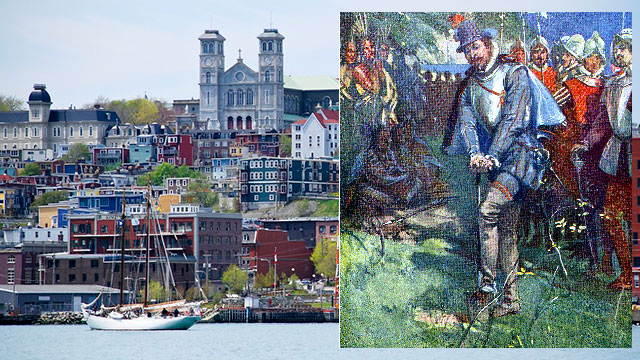Sir Humphrey Gilbert tried to establish England’s first North American colony in St. John’s, Newfoundland, in the 16th century
 England was late in the European scramble for territory in the New World. Although explorers such as John and Sebastian Cabot and plunderers like Sir Francis Drake had sailed ships to North and South America, no attempt had been made by England – unlike Spain, Portugal, and France – to colonize the Western Hemisphere.
England was late in the European scramble for territory in the New World. Although explorers such as John and Sebastian Cabot and plunderers like Sir Francis Drake had sailed ships to North and South America, no attempt had been made by England – unlike Spain, Portugal, and France – to colonize the Western Hemisphere.
The English had faced significant challenges in establishing settlements in Ireland, so the unclaimed lands in the New World, which seemed cold and uninviting, held little appeal. These areas offered no promise of the riches pouring out of Mexico, Bolivia, and Peru. In France, memories of disappointment lingered from the Cartier expedition of 1541, which had returned with fool’s gold and quartz mistaken for valuable ores. The phrase “Faux comme les diamants du Canada” (“As fake as Canadian diamonds”) became a popular saying.
The fishing grounds off Newfoundland had long attracted boats from the Basque Country of Portugal and northern France, and it was common for small camps to be made onshore on the Avalon Peninsula, off Newfoundland, to replenish drinking water supplies or to dry fish. One such seasonal settlement came to be called St. John’s, possibly because it had been St. John the Baptist’s feast day when John Cabot sailed into the harbour in the 1490s. At that time, there was no permanent village there, nor had any European power claimed the territory – that is, until the arrival of Sir Humphrey Gilbert.
 Sir Humphrey Gilbert cutting the first sod in Newfoundland. |
| Related Stories |
| Second World War attack helped shape Bell Island’s history
|
| Proud captain sails to Canada’s other ‘distinct society’: Newfoundland
|
| War, tragedy, and a Broadway hit all part of Gander’s celebrated past
|
Sir Humphrey, the half-brother of Sir Walter Raleigh, was an Elizabethan courtier, soldier, and adventurer. He had won fame and a reputation for ruthlessness in fighting rebels in Ireland and Spaniards in the Netherlands. In the 1560s, he presented Queen Elizabeth with his work, A Discourse of a Discoverie for a New Passage to Cataia (Cathay), where he discussed the possibility of discovering a Northwest Passage from America to China. His route to China was in opposition to the English merchants of the Muscovy Company, who hoped to make it to Asia through a Northeast Passage across the north of Russia.
In 1578, Sir Humphrey led an abortive expedition to North America; its purpose was “to annoy the King of Spain by fitting out a fleet of shippes of war under pretence of a voyage of discovery, and so fall upon the enemies shippes and destroy his trade in Newfoundland and the West Indies, and possess the country.” It was a costly failure, but Sir Humphrey was undaunted.
On Aug. 5, 1583, Sir Humphrey returned to Newfoundland. He came ashore at the place they called St. John’s and claimed the territory for England by placing a marker there and cutting some turf. He noted the presence of many foreign fishing vessels and levied a tax on them in the name of the crown. Lacking sufficient supplies to winter over, however, Sir Humphrey Gilbert did not attempt to establish a permanent colony.
On his return voyage to England, his ship, the Squirrel, encountered heavy seas off the Azores. Crewmen aboard a companion vessel, the Golden Hind (the same name as the ship Francis Drake had used a few years before to circumnavigate the globe), saw Sir Humphrey on deck shouting, “We are as close to heaven by sea as by land.” Shortly after, the Squirrel sank with all hands lost. With it died immediate interest in what was, on paper at least, England’s first North American colony.
St. John’s, however, was not lost. The richness of the Grand Banks fishery kept luring ships to the splendid harbour, and gradually, a year-round town emerged, making it the oldest city in Canada. Wharves, warehouses, naval provisioning, and fish processing sprang up along the shoreline. In 1610, the English government appointed governors to rule what was there and expand the territory’s economy.
English hold on the area did not go unchallenged, however. The value of the fishery and the usefulness of St. John’s Harbour made the town a target during the many European wars of the 17th and 18th centuries. The French attempted to establish their own colony elsewhere in Newfoundland, and in 1692, they captured St. John’s and burned it to the ground. In 1796, amid yet another war, the French returned with allied Spanish ships and destroyed other settlements on the coast of Newfoundland.
The Napoleonic Wars of the early 19th century saw a boom in the price of salt fish that the colony provided, making the area attractive to settlers. Thousands of Irish immigrants arrived, swelling the population of St. John’s. In 1854, the system of responsible government that England was granting to its Canadian colonies was established in Newfoundland, making it essentially a self-governing entity.
Colonial status ended in 1907 when Newfoundland, like Canada, Australia, and New Zealand, became a Dominion of the British Empire. In 1949, Newfoundlanders abandoned any independent future and threw their lot in with the Confederation, making it the 10th Canadian province.
Gerry Bowler is a Canadian historian and a senior fellow of the Frontier Centre for Public Policy.
For interview requests, click here.
The opinions expressed by our columnists and contributors are theirs alone and do not inherently or expressly reflect the views of our publication.
© Troy Media
Troy Media is an editorial content provider to media outlets and its own hosted community news outlets across Canada.
